
Phobaeticus serratipes is a species of stick insect that at one time was the longest known insect, with one female specimen recorded as being 555 mm long. This measurement includes the legs fully extended front and rear, and the actual length of the body alone is considerably shorter. This insect is endemic to Malaysia and Singapore. It is a popular species among those who raise stick insects.

The Phasmatidae are a family of the stick insects. They belong to the superfamily Anareolatae of suborder Verophasmatodea.

Phobaeticus is a genus of Asian stick insects comprising over 25 species. It includes some of the longest known insects, including Phobaeticus chani.
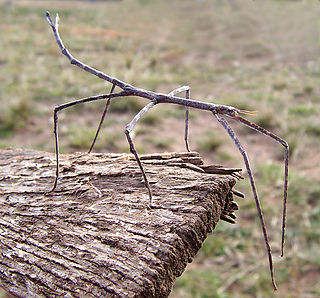
The Phasmatinae are a subfamily of stick insects in the family Phasmatidae. They contain at least three tribes; Bradley and Galil corrected the spelling to "Phasmatinae" and provides a key to tribes.

Peruphasma schultei is a species of stick insect found in the Cordillera del Condor region of northern Peru. In the wild the insect feeds on Schinus plants, but will feed on privet, Aucuba japonica and honeysuckle in captivity. In Peru they are only known to exist in a region of less than 5 hectares, but since their discovery they have become increasingly popular as pets worldwide due to their unusual colouration and they are now bred regularly in captivity.
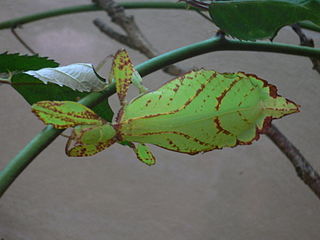
Phyllium is the largest and most widespread genus of leaf insects in the family Phylliidae. They can be found in the Indian subcontinent through to Southeast Asia and Australasia.
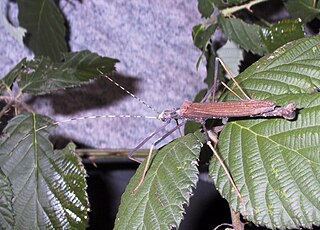
Pseudophasmatidae is a family of stick insect, in the suborder Verophasmatodea, commonly called the "striped walkingsticks". An important identifying characteristic is its mesothorax, which is never more than three times as long as the prothorax.
Malacomorpha is a genus of striped walkingsticks in the family Pseudophasmatidae. There are about 15 described species in Malacomorpha.
Phobaeticus chani or Chan's megastick is a species of stick insect in the tribe Pharnaciini. It is one of the longest insects in the world and was once considered the record-holder. One specimen held in the Natural History Museum in London measures 567 mm (22.3 in). This measurement is, however, with the front legs fully extended. The body alone still measures an impressive 357 mm (14.1 in).
Pharnacia is a tropical Asian genus of stick insects in the family Phasmatidae and subfamily Clitumninae.

Prisopus is a genus of stick insects belonging to the family Prisopodidae. These stick insects are present in America, India and Malesia.

Phryganistria is a genus of stick insects belonging to the subfamily Clitumninae. It was described by the Swedish entomologist Carl Stål in 1875. Members of the genus are found only in Southeast Asia. Of the new species described in 2014, Phryganistria heusii yentuensis, which is 32 cm long, is one of the longest insects known to date. Another, Phryganistria tamdaoensis was selected in 2015 by the International Institute for Species Exploration as one of the "Top 10 New Species" for new species discovered in 2014.
Dajaca is a genus of stick insects belonging to the suborder Verophasmatodea and family Aschiphasmatidae; they have been recorded in Borneo, Vietnam, Hong Kong and Myanmar.

Pseudosermyle is a genus of walkingsticks in the family Diapheromeridae. There are more than 20 described species in Pseudosermyle.

Diapheromerini is a tribe of walkingsticks in the family Diapheromeridae. There are at least 30 genera Diapheromerini.

Phyllium jacobsoni is a species of leaf insect belonging to the family Phylliidae. Its recorded distribution is Java and no subspecies are listed in the Catalogue of Life.
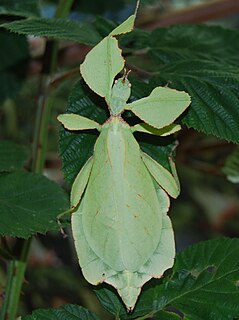
Cryptophyllium westwoodii is a species of leaf insect in the family Phylliidae. It is distributed from the Andaman islands, Myanmar, Indo-China, southern China, Sumatra and the Riouw Archipelago.
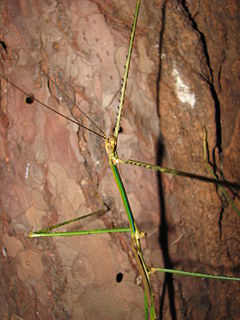
The Clitumninae are a sub-family of stick insects in the family Phasmatidae found in Asia.
Monticomorpha is a genus of striped walkingsticks in the family Pseudophasmatidae. There are 8 described species in Monticomorpha.
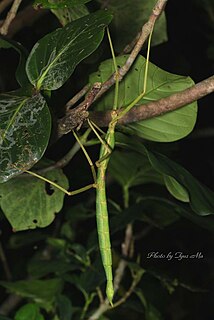
Phasmotaenia lanyuhensis is a species of stick insect, order Phasmatodea. It is endemic to Taiwan. It is often included in the family Phasmatidae, although sometimes excluded from it when the family is strictly delimited. It derives its specific name from its type locality, Lanyuh Island, commonly known as Orchid Island.













